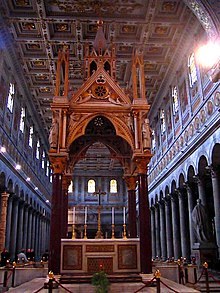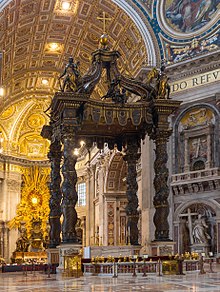Ciborium (altar structure)

A ciborium ( Latin ciborium , drinking cup , plural cibories , see ciborium (vessel) ) is a structure resting on pillars above an altar . Such a stone altar superstructure, an altar ciborium or canopy , is particularly common in churches in Italy.
development
Even in the early Christian basilica , the ciborium was supposed to mark and protect the free-standing altar above the martyr's grave; It is also known as an element of ennobling other important burial sites. On the ciborium above the altar hung the vessel with the consecrated bread and between the pillars were curtains that were drawn during the canon .
An example in Germany from the Romanesque period is the ciborium above the main altar of the Benedictine Abbey Maria Laach , which originally crowned the grave of the founder of the church, i.e. a thematic modification of the canopy above the martyr's grave. The side altars , which appeared in the early Middle Ages , were also fitted with cibories, which now almost always stood in front of a wall or protruded from it. A fine example from the Gothic age are the five ciborian altars in Regensburg Cathedral, decorated with eyelashes , pinnacles and statues .
Bernini's ciborium above the high altar of St. Peter's Church in Rome was decisive for the design in the Baroque period . The ciborium above the high altar in St. Paulin in Trier is an example from Germany.
Web links
Individual evidence
- ↑ Jan Pieper: The ciborium of the Maria Laach abbey church. Form and construction, function and meaning . Geymüller, Verlag für Architektur, Aachen 2016, ISBN 978-3-943164-15-2 .
